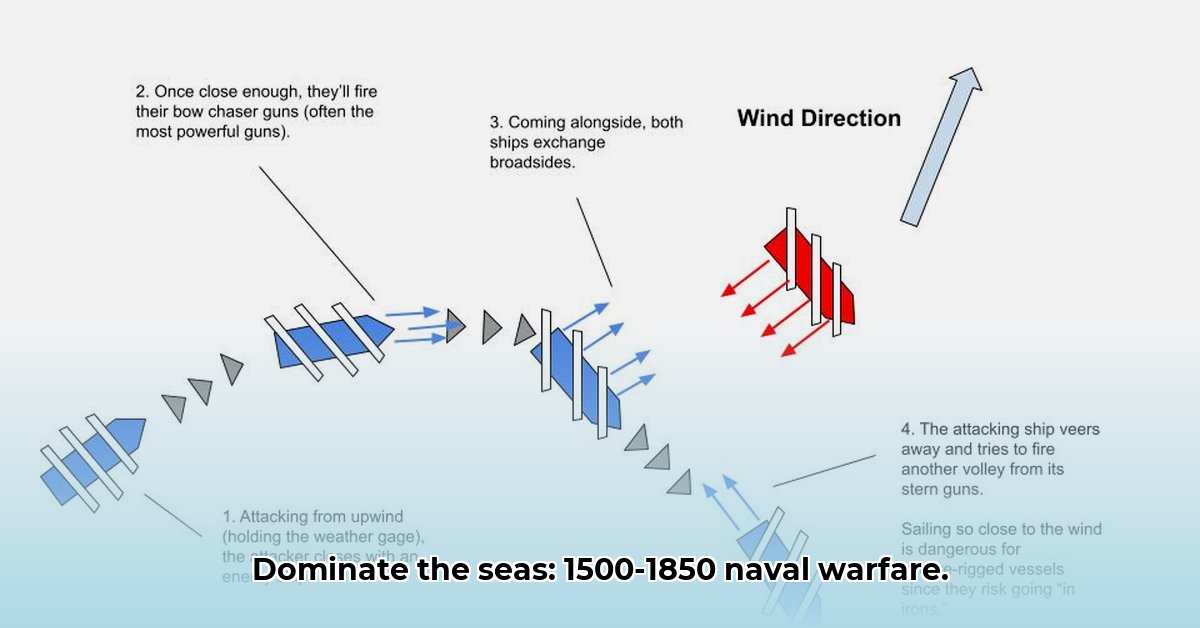
Age of Sail Naval Warfare Strategy: A Chronological Exploration
Imagine a world dominated by the wind, where mighty sailing ships were the ultimate instruments of war. From 1500 to 1850, the Age of Sail witnessed a dramatic evolution in naval warfare, shaped by tactical innovation, technological advancements, and the ever-shifting currents of global politics. This journey explores the key strategies, technologies, and geopolitical consequences that defined this fascinating era of maritime history. For more on naval battles in enclosed seas, check out this resource on the Black Sea: Black Sea battles.
From Swordplay to Broadside: The Transformation of Naval Combat
Early Age of Sail naval battles were chaotic melees of close-quarters combat. Ships clashed, and crews engaged in brutal hand-to-hand fighting, a wild mix of swords and pistols. Cannons existed, but their impact was minimal. How did naval combat change so drastically? The answer lies in the evolution of cannon technology.
By the 17th and 18th centuries, cannons had become the primary weapon, revolutionizing naval warfare. Ships could now inflict devastating damage from a distance, making risky boarding actions less common. This transformation wasn't sudden; it was a gradual process, a steady refinement of tactics and technology. This evolution profoundly altered the nature of sea battles, shifting the balance of power and driving the need for new strategies.
The Line of Battle: A Symphony of Destruction and Coordination
One of the most significant developments was the line of battle – a long line of ships, perfectly aligned, unleashing devastating broadsides. This formation maximized firepower while minimizing individual vulnerability. Mastering the line of battle demanded exceptional skill, discipline, and precise coordination. A single mistake could lead to catastrophe. However, this impressive tactic was not without its challenges.
Did the line of battle always guarantee victory? Absolutely not. It required flawless coordination, and communication breakdowns could easily unravel the entire strategy. Weather conditions further complicated matters; the ability to control the "weather gauge" – having the wind at one's back – often proved decisive. The line of battle represented the peak of Age of Sail tactical thinking, but its success hinged on meticulous planning and flawless execution.
Technological Advancements: The Evolution of Ship Design
The Age of Sail witnessed a remarkable evolution in ship design and construction. Early ships were smaller, carrying fewer, less powerful cannons. As technology advanced, so did shipbuilding. Larger, sturdier vessels emerged, boasting multiple decks, improved gun ports, and vastly more powerful artillery.
The transition from the nimble galleons of the 16th and 17th centuries to the massive ships-of-the-line of the 18th and 19th centuries exemplifies this incredible technological leap. These changes didn't simply enhance firepower; they fundamentally redefined naval strategy. The sheer size and firepower of ships-of-the-line gave them a considerable advantage in line-of-battle engagements, shifting the tactical landscape dramatically. How did these technological advancements shape the strategic thinking of naval commanders? The answer lies in the interplay between firepower, maneuverability, and the ability to control the seas.
Global Domination: Naval Power and Geopolitical Influence
Naval power was inextricably linked to global influence. Nations with powerful navies controlled trade routes and established vast colonial empires. Britain's rise to global dominance serves as a prime example. Its Royal Navy's mastery of Age of Sail naval warfare strategy allowed it to project power across the oceans and shape the world’s political landscape for centuries. The control of the seas was, and remains, the key to global influence, a reality starkly illustrated by the era's history.
The Sunset of Sail: A New Era Dawns
By the mid-19th century, the Age of Sail was drawing to a close. Steam power and the development of ironclad warships rendered traditional wooden sailing ships obsolete. Although the era ended, the strategic principles developed during the Age of Sail continue to inform naval strategy to this day. The importance of coordinated action, effective communication, and control of the seas remain fundamental aspects of modern naval warfare. The legacy of this era lives on.
Key Takeaways
- The Age of Sail witnessed a dramatic shift from close-quarters boarding actions to the dominance of the line of battle.
- Technological advancements in cannons and shipbuilding fundamentally altered naval warfare.
- Naval power was directly linked to global political and economic dominance.